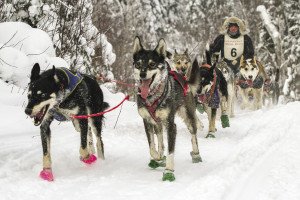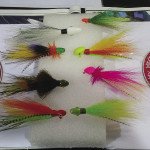In almost any condition Mother Nature presents, we like to say it’s good training for the dogs. If it’s 20 below zero, it’s good training. If there is 10 inches of fresh powder and the dogs have to break trail—it’s good training. If it’s warm or if it’s raining or we are running through beaver ponds—as the case was this fall—it’s good training. The only time it’s not good training would be if conditions are not safe (too icy), or we teach the dogs to do something we don’t want them to do—even if inadvertently (like turn around in the middle of the trail).
Then, when it’s raining or dumping snow or warm or brutal cold during a race, we know we trained properly. It helps us keep a positive attitude as well—there’s probably such a thing as a perfect trail, but how many times do we actually get to run on a perfect trail?
The Gunflint Mail Run, which took place on Jan. 9, saw 10 teams run the 12-dog, 100-mile race and 13 teams run the 8-dog, 60-mile race. Matt and I entered a team in each class.

My 8-dog team consisted of a few older dogs, a couple of young dogs who had little race experience and a few race veterans, but in general, was more of a “B” team. Matt had 10 race veterans and two dogs new to racing that we hoped might make the Beargrease team. Because the Beargrease requires a 14-dog team, we wanted to train up as many of our dogs as possible to have a large pool of race-ready dogs.
Some highlights from my race included: watching Odin Jorgenson try to finish changing my sled runners about three minutes before my start time. At one point, Odin was supposed to go help another team get to the starting chute, but my runners were only half on the sled and hardly budging. He looked at me and looked at my runners and stayed to get the job done. Thanks, Odin.
Later, on the trail, in a small moment of chaos, I did a head-on pass going straight down a hill. At the bottom, another team was parked. It’s difficult to stop at the bottom of a steep hill and I couldn’t stop. There was ski pole sticking out the side of Adam Treeful’s sled, which caught on my sled bow and started dragging down the trail. It took me 100 feet to stop my team and by the time I did, the ski pole was destroyed. Sorry about that pole, Adam.
The 12-dog teams had to run through a small mud hole, which was deep enough that the dogs had to swim and the mushers had to wade. After the first loop, dogs came back all iced up and one musher reported going through the mud on her stomach. The race judges took a vote and almost all the mushers voted to run through the mud pond again, rather than shorten the course.
Reports from the second loop included one musher wading through the water up to his waist to retrieve his team from the trees on the side of the pond, while another musher had frostbite on his feet by the end of the race (temps were dipping below zero by the time the race finished). Perhaps it was our many run-ins with open water this fall, but our team didn’t have any problems—they ran through—just as we trained them to do. And while Matt’s feet were wet, he came through okay, too.
The highlight of Matt’s race was on the second leg, when he tried tossing some Little Debbie snacks to volunteers who were helping at the turn-around. Somehow the tossing action caused his sled to overturn and he did the turn around on his stomach. Turns out the volunteers never even saw the treats—just a musher getting dragged behind his team.
Sometimes, the many factors that play into dog racing come together for a team, and they did for Matt and his team that night. By the time he was half-way through the second loop of the race, he could feel the team charging ahead, not slowing down. He passed two teams on the way back to the finish and when the team reached Poplar Lake, he could see the first place team’s headlamp up ahead. The lake wasn’t quite long enough though—Matt’s team came in less than two minutes behind Ward Wallin, putting Matt in second place.
As of now, we’ve trained almost 1,200 miles this year and in the warm, cold, rain and snow. We have three weeks until the Beargrease, which will be 380 miles this year, starting Jan. 31. This will be my second Beargrease Marathon and I go into it knowing what to expect—though this doesn’t make it any easier. The race will be different every year and I look forward to what this year’s adventure brings.





